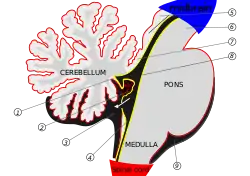| Median aperture | |
|---|---|
 Scheme of roof of fourth ventricle. The arrow is in the median aperture. | |
| Details | |
| Identifiers | |
| Latin | apertura mediana ventriculi quarti |
| NeuroNames | 641 |
| TA98 | A14.1.05.722 |
| TA2 | 5970 |
| FMA | 75015 |
| Anatomical terms of neuroanatomy | |
The median aperture (also known as the medial aperture, and foramen of Magendie) is an opening of the fourth ventricle at the caudal portion of the roof of the fourth ventricle.[1] It allows flow of cerebrospinal fluid (CSF) from the fourth ventricle into the cisterna magna.[2][3] The other two openings of the fourth ventricle are the lateral apertures - one on either side.[4] Nonetheless, the median aperture accounts for most of the outflow of CSF out of the fourth ventricle. The median aperture varies in size.[1]
Anatomy
Relations
The median foramen on axial images is posterior to the pons and anterior to the caudal cerebellum. It is surrounded by the obex and gracile tubercles of the medulla, tela choroidea of the fourth ventricle and its choroid plexus, which is attached to the cerebellar vermis.[4]
Eponym
The foramen of Magendie is named for François Magendie, who first described it.[5]

Additional images
 Median aperture
Median aperture
References
- 1 2 Waxman, Stephen G. (2009). Clinical Neuroanatomy (26th ed.). New York: McGraw-Hill Medical. p. 150. ISBN 978-0-07-160399-7.
- ↑ Johns, Paul (2014). "Development of the brain". Clinical Neuroscience. Elsevier. pp. 19–26. doi:10.1016/b978-0-443-10321-6.00002-3. ISBN 978-0-443-10321-6.
The choroid plexuses are highly vascular structures that project into each of the ventricles and continuously produce cerebrospinal fluid by active secretion from the blood. CSF escapes from the fourth ventricle (to the subarachnoid space) via three openings: the single median aperture and the two lateral apertures. It is ultimately reabsorbed into the venous system via the arachnoid granulations which run along the superior aspect of the cerebral hemispheres ... correspond to the arachnoid villi, finger-like projections into a large venous channel called the superior sagittal sinus.
- ↑ Singhal, Vasudha; Prabhakar, Hemanshu (2016). "Hydrocephalus". Complications in Neuroanesthesia. Elsevier. pp. 21–27. doi:10.1016/b978-0-12-804075-1.00003-1. ISBN 978-0-12-804075-1.
CSF is produced by the choroid plexuses of the lateral, third, and fourth ventricle. The production of CSF is not pressure regulated, and it continues to be produced even if the reabsorption mechanisms are obstructed. The circulation of CSF is as follows: Lateral ventricle → interventricular foramen of Monroe → third ventricle → aqueduct of sylvius → fourth ventricle → foramen of Magendie (median aperture)/foramen of Luschka (lateral aperture) → subarachnoid space.
- 1 2 Ciolkowski M.; Sharifi M.; Tarka S.; Ciszek B. (2011). "Median aperture of the fourth ventricle revisited". Folia Morphol. 70 (2): 84–90. PMID 21630228.
- ↑ synd/2388 at Who Named It?